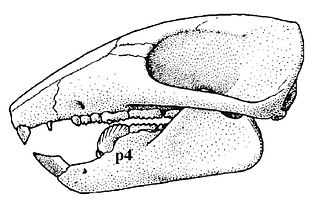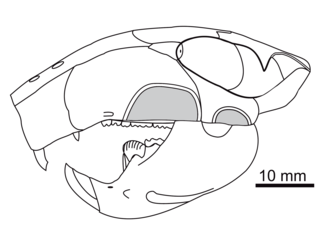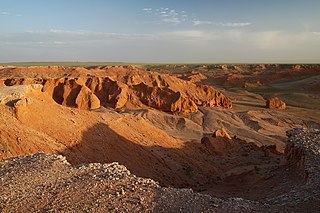Eobaatar is a genus of extinct mammal from the Lower Cretaceous of Mongolia, Spain and England. A member of the also extinct order Multituberculata, it lies within the suborder Plagiaulacida and family Eobaataridae. The genus Eobaatar was named by Kielan-Jaworowska Z., Dashzeveg D. and Trofimov B.A. in 1987. Its name was made from Greek "eos" = "dawn" and Mongolian "baatar" = "hero"", "warrior".
Monobaatar is a genus of extinct mammal from the Lower Cretaceous of Mongolia. It was within the also extinct order Multituberculata, and lived during the "age of the dinosaurs". It is also within the suborder "Plagiaulacida" and has been tentatively referred to the family Eobaataridae, though it probably is not a member.

Sinobaatar is a genus of extinct mammal from the Lower Cretaceous of China. It is categorized within the also extinct order Multituberculata and among these it belongs to the plagiaulacid lineage. Sinobaatar was a small herbivore during the Mesozoic era, commonly called "the age of the dinosaurs". The genus was named by Hu Y. and Wang Y. in 2002. Three species have been described.
Sloanbaatar is a mammal genus that lived in Mongolia during the Upper Cretaceous. It lived at the same time as the dinosaurs. This animal was a member of the also extinct order Multituberculata within the suborder Cimolodonta and the family Sloanbaataridae.
Nessovbaatar is a genus of extinct mammal from the Upper Cretaceous of Mongolia. It eked out its living in the company of Central Asian dinosaurs. This animal was a member of the extinct order Multituberculata within the suborder Cimolodonta and family Sloanbaataridae.
Bulganbaatar is an extinct genus of early mammals from the Upper Cretaceous.

Nemegtbaatar is an extinct genus of mammal from the Upper Cretaceous Period of what is now Central Asia. It belonged to the order Multituberculata. Nemegtbaatar is within the suborder Cimolodonta and is a member of the superfamily Djadochtatherioidea.

Djadochtatherium is a mammal genus that lived in Mongolia during the Upper Cretaceous. It coexisted with some of the late dinosaurs. This animal was a member of the extinct order of Multituberculata. It is within the suborder of Cimolodonta, and a member of the family Djadochtatheriidae. It was named by G. G. Simpson in 1925, the name meaning "Djadokhta beast".

Kryptobaatar, also known as Gobibaatar or Tugrigbaatar, is an extinct mammalian genus dating from the Upper Cretaceous Period and identified in Central Asia. This animal was a member of the extinct order of Multituberculata within the suborder Cimolodonta, and was a member of the family Djadochtatheriidae. It lived contemporaneously with some of the dinosaurs. Its skull had a length of perhaps 3 cm.

Tombaatar is a mammal genus that existed during the Mongolian Upper Cretaceous period. It co-existed with some of the late dinosaurs. This animal was a member of the extinct order Multituberculata, within the suborder Cimolodonta and family Djadochtatheriidae. The genus Tombaatar was named by Rougier G.W., Novacek M. and Dashzeveg D. in 1997.
Buginbaatar is an extinct genus of mammal from the Upper Cretaceous of Mongolia. It is a member of the extinct order Multituberculata, within the suborder Cimolodonta and family Cimolomyidae. It lived towards the end of the Mesozoic era.

Avimimus, meaning "bird mimic", is a genus of oviraptorosaurian theropod dinosaur, named for its bird-like characteristics, that lived in the late Cretaceous in what is now Mongolia, around 85 to 70 million years ago.

The Djadochta formation is a highly fossiliferous geological formation in Central Asia, Gobi Desert, dating from the Late Cretaceous period, about 75 million to 71 million years ago. The type locality is the Bayn Dzak locality, famously known as the Flaming Cliffs. Reptile and mammal remains are among the fossils recovered from the formation.
Nanocuris is an extinct genus of Deltatheridiidae from the Cretaceous of Canada (Saskatchewan) and United States. Initially, it was classified in a proper family, Nanocuridae, in the clade Eutheria, but a reanalysis of a new specimen revealed a delthatheroid affinity of the genus.
Ukhaatherium is a now extinct species of mammal that lived during the upper Cretaceous about 84 to 72 million years ago in today's East Asia. It is known above all from the fossil locality Ukhaa Tolgod, Mongolia. An adult Ukhaatherium has an estimated weight of about 32g and bears several similarities to lipotyphlan insectivorans such as the tenrec.
The "Gurlin Tsav" skull is a currently unnamed carnivorous metatherian fossil from the Nemegt Formation of Mongolia. Composed of a single semi-complete skull, this specimen is notable in regards to the evolution and systematics of Metatheria as a whole, and thus nigh-omnipresent in phylogenetic analyses of this group.

Tsagandelta is a genus of deltatheroidean therian mammal that lived in Asia during the Late Cretaceous. Distantly related to modern marsupials, it is part of Deltatheroida, a lineage of carnivorous metatherians common in the Cretaceous of Asia and among the most successful non-theropod carnivores of the region. It represents the first known mammal from the Bayan Shireh Formation.

Yubaatar is a genus of multituberculate, an extinct order of rodent-like mammals, which lived in what is now China during the Late Cretaceous. The first specimen was discovered in the Qiupa Formation of Luanchuan County, in the Henan Province. The specimen consists of a partial skeleton with a nearly complete skull, and was made the holotype of the new genus and species Yubaartar zhongyuanensis by the Chinese palaeontologist Li Xu and colleagues in 2015. The generic name consists of the word Yu, which is the pinyin spelling of the Chinese character for the Henan Province, and the Mongolian word baatar, which means "hero", a word commonly used as suffix in the names of Asian multituberculates. The specific name comes from Zhongyuan, an ancient name for the geographic area of the province.

Asiatherium is an extinct genus of mammal, probably belonging to Metatheria. It lived during the Late Cretaceous, and its fossilized remains were discovered in Mongolia.
Albertatherium is an extinct genus of alphadontid metatherians that lived during the Late Cretaceous of North America. The genus contains two species, Albertatherium primus, and Albertatherium secundus. Fossils have been found in the Eagle Formation of Montana and the Milk River Formation of Alberta.













